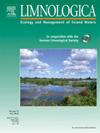有机氮促进褐化湖泊中鞭毛藻的扩张:来自古湖泊记录的证据
IF 2
4区 环境科学与生态学
Q2 LIMNOLOGY
引用次数: 0
摘要
陆地衍生的溶解有机物(DOM)越来越多地流入湖泊,通常被称为褐变,这是一种普遍现象,具有重大的生态和社会后果。褐变通常与混合营养型植物鞭毛藻(PFs)的增殖有关,但其潜在机制仍存在争议。在这项古湖泊学研究中,对挪威东南部七个湖泊的沉积物岩心进行了分析,以评估PF成功的潜在驱动因素的作用。该研究聚焦于两种生态上不同的PFs, Gonyostomum semen和cryptophytes,使用色素生物标志物重建它们的历史丰度,以及DOM、营养和气候的代用物。分段回归分析显示,两种PFs的增加具有相对较高的同步性。广义加性模型发现氮是最一致的预测因子,而DOM是氮浓度的主要预测因子。这些发现支持了褐变主要通过增加作为DOM组成部分进入湖泊的有机氮的输入来促进PF扩展的假设。其他提出的机制,如加强分层、降低透明度或铁富集,并没有得到湖泊间一致的支持。褐化和森林覆盖率增加的时间格局表明,历史土地利用变化,特别是造林和湿地排水,对森林的影响很大。本研究结果强调了土地利用遗产在形成浮游植物群落结构中的重要性,并为内陆水域持续DOM富集的生态后果提供了新的见解。本文章由计算机程序翻译,如有差异,请以英文原文为准。
Organic nitrogen fuels phytoflagellate expansion in browning lakes: Evidence from paleolimnological records
The increasing influx of terrestrially derived dissolved organic matter (DOM) into lakes, commonly referred to as browning, is a widespread phenomenon with significant ecological and societal consequences. Browning is frequently associated with the proliferation of mixotrophic phytoflagellates (PFs), yet the underlying mechanisms remain debated. In this paleolimnological study, sediment cores from seven lakes in southeastern Norway were analyzed to assess the role of potential drivers of PF success. The study focused on two ecologically distinct PFs, Gonyostomum semen and cryptophytes, using pigment biomarkers to reconstruct their historical abundance alongside proxies for DOM, nutrients, and climate. Piecewise regression analysis revealed increases in both PFs with a relatively high degree of synchrony. Generalized additive models identified nitrogen as the most consistent predictor of PF-specific pigments, while DOM was the primary predictor of nitrogen concentrations. These findings support the hypothesis that browning promotes PF expansion primarily by increasing the input of organic nitrogen that enters lakes as a component of DOM. Other proposed mechanisms, such as enhanced stratification, reduced transparency, or iron enrichment, were not consistently supported across lakes. The temporal patterns of browning and increasing PF success suggest a strong influence from historical land-use changes, particularly afforestation and wetland drainage. Results of the present study highlight the importance of land-use legacies in shaping phytoplankton community structure and provide new insights into the ecological consequences of ongoing DOM enrichment in inland waters.
求助全文
通过发布文献求助,成功后即可免费获取论文全文。
去求助
来源期刊

Limnologica
环境科学-湖沼学
CiteScore
3.70
自引率
5.90%
发文量
64
审稿时长
3 months
期刊介绍:
Limnologica is a primary journal for limnologists, aquatic ecologists, freshwater biologists, restoration ecologists and ecotoxicologists working with freshwater habitats.
 求助内容:
求助内容: 应助结果提醒方式:
应助结果提醒方式:


